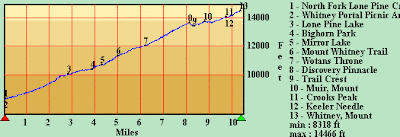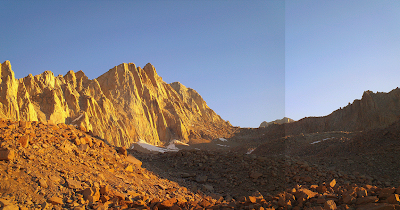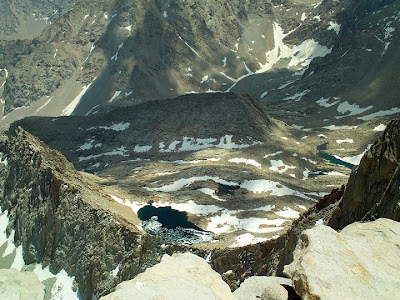Part 2:
Summit to Trail Camp (Point 6 to Point 4)
~14,500' to ~12,000'
~5 mi (~2500' elevation change)
Left Summit (Point 6) ~1400 hr
Arrived Trail Crest (Point 5) ~1615 hr; Left ~1645 hr
Trail Camp (Point 4) ~1900 hr
 Click on map to enlarge (or any photograph, for that matter).
Click on map to enlarge (or any photograph, for that matter).
 Looking off the northwest shoulder of Mt. Whitney
Looking off the northwest shoulder of Mt. Whitney
(Wales Lake above ridge in foreground).
~14,500' to ~12,000'
~5 mi (~2500' elevation change)
Left Summit (Point 6) ~1400 hr
Arrived Trail Crest (Point 5) ~1615 hr; Left ~1645 hr
Trail Camp (Point 4) ~1900 hr
 Click on map to enlarge (or any photograph, for that matter).
Click on map to enlarge (or any photograph, for that matter).Climbing a mountain all the way to the summit, and certainly one as high as Mt. Whitney, feels marvelous! But it's not quite time to celebrate---a trip isn't a success until it's finished safely, and the top is only halfway on this trip! We climbed to the various corners of the mountaintop to say our goodbyes to this incredible view we'd come so far to see.
 Looking off the northwest shoulder of Mt. Whitney
Looking off the northwest shoulder of Mt. Whitney(Wales Lake above ridge in foreground).
By 1400 hr (2 pm), we were headed off the backside of Whitney and pointing back the way we came. And you know what the coolest part was? I no longer had to worry about conserving my camera battery, so I could take pictures all the way back!
 Heading back across the ice "pinnacles"
Heading back across the ice "pinnacles"(two of the "needles" closest to Whitney visible in the upper right).
But where the heck did those clouds come from?! Mt. Whitney is notorious for this, no? The formerly blue cloudless skies now held clouds that played hide-and-go-seek with the sun over our vistas. The ones above the summit held a dark tinge to them, but were still too wispy to really be a threat in the next half-hour or so. Still, the wind had come up even more, and people were beginning to scurry down from the summit. Those summiting after us weren't pausing to linger long!
Now, you would think going back would be easier, right? It's downhill, right? Life doesn't always work the way we think it will! First: when we were going downhill, it was on talus, then the ice patch, then loose scree, decomposing granite and sand. And that's just to Trail Crest! Second: the trail still has plenty of uphill left in it --- especially that part leading up to Trail Crest and Discovery Pinnacle. Third: we were already exhausted, short of breath from the high altitude, and walking on raw feet that burned with every step.
Many mountaineers die AFTER summiting; so this is no time to get cocky and misstep. I know my doctors live in fear of me breaking a bone out here, and I just CAN'T let that happen. So EVERY SINGLE STEP must be a certain slow rhythm so different from my former natural gait: plant the walking stick and ensure it's planted firmly. Step. Check footing is firm. Step. Check that footing is firm. Lift walking stick and re-plant. Repeat ad nauseum. It's hard for a former fast walker like me to settle into this; it's made easier after chemotherapies and at this altitude when everything is required to be slower and more mellow.
Still, I slip. I slide. I stumble. I am tired. The pads of my feet and toes burn and feel raw raw raw. A rock shifts under my foot and I twist my ankle; not bad. A little further on, another rock shifts and I slide a good 12 in. I twist my knee; still not bad. I just keep going; taking my time by taking pictures, pulling off the trail to let others overpass us each way, and staying hydrated.
 Love those window views!
Love those window views!Here you can see all the way back to the alpine green heart
of Bighorn Park, between Mirror Lake and Outpost Camp (Point 3).
 John Muir Wilderness, Sequoia National Park
John Muir Wilderness, Sequoia National Park(NW Hitchcock Lake looking in the direction of Timberline Lake).
 It took 3 pictures just to give you an idea
It took 3 pictures just to give you an ideaof what's right in front of my face (forget peripherally).
Cameras cannot capture the reality!


I felt comfortable with the rate we were making; it was slow enough to be pleasant and still enough ahead of schedule that losing the light was not foreseeable. We stopped at Trail Crest for a little dinner break.

 Trail Crest: Trail Camp (center right), nearby lakes, and
Trail Crest: Trail Camp (center right), nearby lakes, andthe surrounding valley are in cloud shadows.
Really taking time out to rest my feet while eating dinner at Trail Crest left me feeling revived and ready to take on the last part between me and my pack/bed: the notorious switchbacks!
But again, downhill is not as fast as one would think it would be. Again it's loose scree, an ice patch, and decomposing granite and sand. Again EVERY SINGLE STEP, plant the walking stick and ensure it's planted firmly. Step. Check footing is firm. Step. Check that footing is firm. Lift walking stick and re-plant. Repeat ad nauseum.



We paused on the switchbacks above the cables for our last view of Mt. Whitney. The sinking sun was striking on the little lightning shelter, allowing our naked eye to see how far we had come since summiting. Soon we would be back at camp.
We made it past the cables and were on the switchbacks just below them when it happened---a rock gave way beneath my foot, pitching me sideways on a narrow section of trail. To try to save myself the fall would mean injuring my ankle (BT; DT); I abandoned resisting and let myself hit the ground. I came down HARD.
Fortunately, I came down on the seat of my pants, one hand, and one hand with the camera underneath it (didn't even try to save the camera---for the first time in my life, I worried about me MORE!). I took inventory. Although I ached and stung, only the hand that had taken the full impact with the trail had indentations from rocks and redness from the slap. I had no broken skin, and thank the Lord, no broken bones or inoperable parts. Eighteen months ago, such a fall would have SHATTERED numerous bones in my body. WOW! I felt very blessed to have survived the fall. But I still felt like whimpering a little. I was ready to be off the trail for the day! Too bad there was still a bit of it to go---no magic carpet ride awaited me. Time to pick myself up and move on. I figured I'd take my mind off my aching, sore, tired, marched-out body by taking a few more flower and scenery pictures!

 The little lakes above Trail Camp (N) in the shadows.
The little lakes above Trail Camp (N) in the shadows.Flowers prolifically dot the mountainsides at this elevation.
The warm day had not only decreased the amount of snow at The Cables, it had also melted all the snow and ice around the springs that "cross" the switchbacks. Where in the morning the flowing water on the trail had been very low with patches of ice, it was now a surging stream deep enough that keeping boots and pant bottoms dry would prove to be impossible without resorting to the ridiculous. It only added to my misery. Now I was tired, cold, and wet! My footing was even more sketchy on this wet stream-section of trail. I splashed, I slipped, I slid, I stumbled some more. The trail is no place for whiners, because even nonwhiners sometimes feel like whining out here. If we got started, how would we ever stop? Ya just gotta love it. I was relieved to see dry switchbacks ahead.

 Looking down the switchbacks.
Looking down the switchbacks.The shadow of Mt. Muir's peak is pointing almost directly at our campsite at Trail Camp.
Finally we reached the end of the switchbacks. A couple we'd seen on the trail a few times were waiting as we approached Trail Camp. "Congratulations, " they called. "We were just starting to worry." Heck, I didn't have to use my headlight; I was back before dark! But as it turns out, we were indeed the very last ones off the switchbacks that day.
The air was already chilling rapidly as the sun dropped behind Mt. Muir. I didn't know how I would find the strength to climb to our "third-floor walkup" campsite. DH and I were so weak and tired, we simply clung to each other and our walking sticks as we picked our way up. We headed for a pitstop, then to our campsite to start setting up our groundcloth (outdoor blanket) and mummy bags. I was shivering before we were done. It was obvious it was going to be a lot colder tonight!
I ate a few more bites of jerky and trail mix but wasn't really hungry. I drank more water, now that I had room for guzzling some. We crawled into our mummy bags before the sun had even fully set, let alone before the light was out of the sky! As I lay there watching the shadows get longer and the marmots come out to investigate what everyone was having for dinner, I got colder and colder and shivered to the point of all my muscles going into really painful spasms. Uh-oh!
"I'm freezing," I told DH with chattering teeth. "I can't get warm enough." I was already wearing tights and pants on bottom; and bra, undershirt, sweatshirt tunic, and thin Indian blouse on top. DH was lying in his bag with it unzipped, pouring sweat.
"Here," he said, and pulled off his second-layer sweats for me to wear. I pulled the bottoms on over all my layers, peeled off the Indian blouse, and pulled the top on over my own sweatshirt. Then I tucked myself back into my bag, pulled all the cords tight around me, and exhaled into the bag to help warm up. I didn't even bother with the mosquito hat tonight; the Cutter's was doing fine at keeping the skeeters at least a foot above us.
I lay there for a long time, watching as the last light went out of the sky and Venus put in her appearance. Other stars came out. No one ever did come down the switchbacks after us, unlike on Saturday night when dayhikers picked their way down till after 9 at night. We really were the last ones; the slowest ones. But we made it safely back to our "beds" that night!
The air was already chilling rapidly as the sun dropped behind Mt. Muir. I didn't know how I would find the strength to climb to our "third-floor walkup" campsite. DH and I were so weak and tired, we simply clung to each other and our walking sticks as we picked our way up. We headed for a pitstop, then to our campsite to start setting up our groundcloth (outdoor blanket) and mummy bags. I was shivering before we were done. It was obvious it was going to be a lot colder tonight!
I ate a few more bites of jerky and trail mix but wasn't really hungry. I drank more water, now that I had room for guzzling some. We crawled into our mummy bags before the sun had even fully set, let alone before the light was out of the sky! As I lay there watching the shadows get longer and the marmots come out to investigate what everyone was having for dinner, I got colder and colder and shivered to the point of all my muscles going into really painful spasms. Uh-oh!
"I'm freezing," I told DH with chattering teeth. "I can't get warm enough." I was already wearing tights and pants on bottom; and bra, undershirt, sweatshirt tunic, and thin Indian blouse on top. DH was lying in his bag with it unzipped, pouring sweat.
"Here," he said, and pulled off his second-layer sweats for me to wear. I pulled the bottoms on over all my layers, peeled off the Indian blouse, and pulled the top on over my own sweatshirt. Then I tucked myself back into my bag, pulled all the cords tight around me, and exhaled into the bag to help warm up. I didn't even bother with the mosquito hat tonight; the Cutter's was doing fine at keeping the skeeters at least a foot above us.
I lay there for a long time, watching as the last light went out of the sky and Venus put in her appearance. Other stars came out. No one ever did come down the switchbacks after us, unlike on Saturday night when dayhikers picked their way down till after 9 at night. We really were the last ones; the slowest ones. But we made it safely back to our "beds" that night!























































